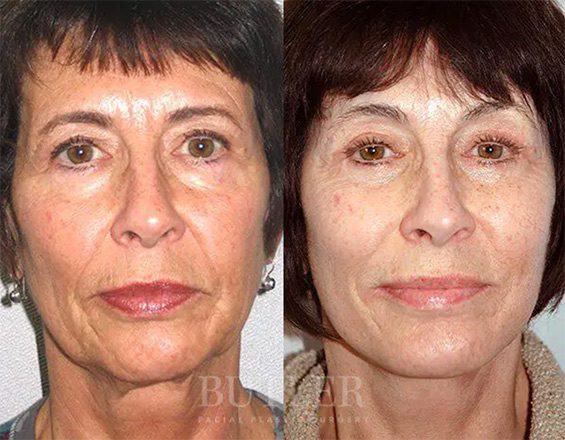
Facelift surgery (rhytidectomy) is one of the most popular cosmetic procedures for those looking to turn back the clock. It addresses sagging skin, deep lines, and lost volume. But one of the biggest concerns patients have is the pain involved. Knowing what facelift surgery entails, how the recovery feels, and how the pain is managed will help make the decision less scary.
5 Min Read:
Types of Facelift Surgery
There are several types of facelifts, including:
- Mini Facelift: For subtle rejuvenation.
- Traditional Facelift: When a more dramatic outcome is desired.
- Deep-Plane Facelift: For volume restoration and natural-looking results.
- Comprehensive Facelift: When adding eyelid surgery or a brow lift.
Each technique targets different degrees of aging and will have slightly different recovery experiences.
5 Stages of Facelift Recovery
A facelift is usually performed under general anesthesia so patients don’t feel any pain during the procedure. However, as the anesthestic wears off, they will feel some post-surgical discomfort. Most of the time, facelift pain is mild to moderate and can be easily managed. The following breakdown explains the typical discomfort most patients can experience at each stage of facelift recovery.
- Immediately After Surgery: When waking after surgery, the lingering effects of anesthesia will likely prevent any pain. However, as the anesthetic wears off, patients may feel some tightness, soreness, and pressure.
- Days One to Three of Recovery: Facelift discomfort is the most intense during the first few days after the surgery. Swelling and bruising are at their peak and can cause facial tenderness, achiness, and sometimes, throbbing. Patients are usually told to rest and avoid strenuous activities during this period, which will help reduce pain. Applying cold compresses (as advised by your surgeon) may help with some discomfort and reduce swelling. Painkillers are usually prescribed for the first few days and can be taken as directed to help with pain.
- Week One to Two Post-Surgery: By the end of the first week, pain intensity usually decreases, but some soreness, tightness, and itchiness will be present as healing progresses. The swelling and bruising starts to subside. Most patients can switch from prescription pain medicine to over-the-counter medication recommended by their surgeon after the first week. During this phase, patients may experience numbness or tingling near the incision sites ranging in intensity. However, it’s an expected part of the healing process as nerves begin to regenerate.
- Week Three to Four After Surgery: As patients enter weeks three and four, swelling and bruising have significantly subsided. Tightness is usually the primary sensation at this point, which can limit wide smiles or animated facial expressions. Itching around the incisions may increase, and some residual numbness is common, both of which are temporary.
- Month One and Beyond: By the end of the first month, swelling, bruising, and discomfort have dissipated. For some, mild discomfort around the incision sites or underlying tissues may persist but is usually manageable and will improve over time.
Pain Management Strategies During Facelift Recovery
Your surgeon will prescribe or recommend one or more of the following for pain management:
Prescription Pain Medication
For the first few days after facelift surgery, prescription pain medicine will provide relief for moderate discomfort.
Over-the-Counter Pain Relief
Once the worst of the pain is over, patients can switch to over-the-counter options like acetaminophen to manage residual soreness. Aspirin or NSAIDs (like ibuprofen) can increase bleeding.
Cold Compresses
Applying cold compresses in the first 48 hours can help reduce swelling and provide temporary pain relief, but ice shouldn’t have direct contact with the skin.
Head Elevation
Sleeping with the head elevated at a 30 to 45-degree angle will help reduce facial swelling and pressure and alleviate some discomfort. Most patients are advised not to sleep on their sides for several weeks after surgery.
Resting Up and Gentle Facial Movements
Getting plenty of rest is essential, and avoid all strenuous activities (and heavy lifting) until cleared by the surgeon. Gently moving your facial muscles will prevent stiffness, which can add to discomfort.
Follow-ups and Post-op Instructions
Following the surgeon’s post-operative instructions and attending all follow-up appointments will keep healing on track, help prevent complications, and ensure any discomfort or complications can be addressed.
Why Choose a Facial Plastic Surgery Specialist?
The surgeon’s skill and technique make a big difference in both the facelift results and the recovery experience. A board-certified facial plastic surgeon has performed many facelifts and can minimize trauma to the underlying tissues, making recovery smoother and less painful. They may also use advanced techniques like short-scar or SMAS facelifts, which can reduce tissue disruption, swelling, and pain.
Factors That Can Affect Facelift Pain
Each patient’s experience with facelift pain will vary based on:
- The Type of Facelift: A full facelift will have a longer and slightly more uncomfortable recovery than a mini-lift as it involves more tissue repositioning.
- Pain Tolerance: Everyone’s pain tolerance is different. Some people may feel and manage pain differently than others.
- The Quality of Post-surgical Care: Following post-op instructions will reduce discomfort. Those who follow post-op instructions will recover with less pain and a reduced risk of complications.
- Possible Complications: Infection, hematoma, or delayed healing can cause more pain. Proper wound care and regular follow-ups will minimize these risks.
- Additional Procedures: Another question to consider is whether or not you are planning to combine your facelift with another cosmetic facial surgery, like a neck lift, brow lift, or eyelid surgery. Additional surgeries can make recovery discomfort more intense or last a little longer. However, if you or your plastic surgeon feels a complementary procedure will deliver more balanced results, adding it during your facelift will prevent a subsequent surgery and the pain that accompanies a separate recovery period.
Looking for a Top Facelift Surgeon in Santa Monica, CA?
Dr. David Butler is a double board-certified facial plastic surgery specialist in Santa Monica, California.

He has a compassionate bedside manner, makes safety his first priority, and is a meticulous surgeon, so you can feel confident when you choose our Santa Monica facelift specialist for your surgery.
See Dr. Butler’s before and after facelift photos, and call (310) 428-0033 to schedule your in-depth facelift consultation.
